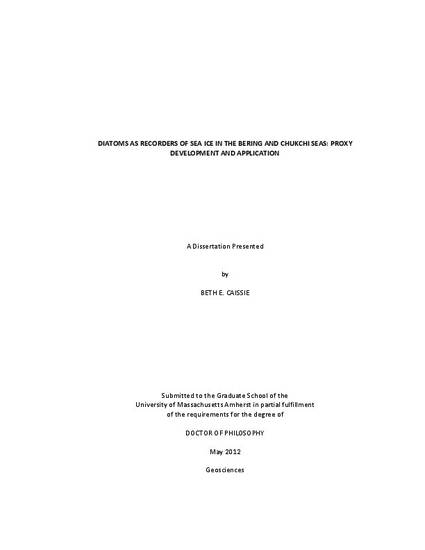
Dissertation
Diatoms as Recorders of Sea Ice in the Bering and Chukchi Seas: Proxy Development and Application
(2012)
Abstract
The recent, rapid decline in Arctic summer sea ice extent has prompted questions as to
the rates and magnitude of previous sea ice decline and the affect of this physical change on icerelated
ecosystems. However, satellite data of sea ice only extends back to 1978, and mapped
observations of sea ice prior to the 1970s are sparse at best. Inventories of boreal ecosystems
are likewise hampered by a paucity of investigations spanning more than the past few decades.
Paleoclimate records of sea ice and related primary productivity are thus integral to
understanding how sea ice responds to a changing climate. Here I examine modern
sedimentation, decadal‐scale climate change in the recent past, and centennial‐ to millennialscale
changes of the past 400 ka using both qualitative and quantitative diatom data in concert
with sedimentology and organic geochemistry.
Diatom taxonomy and corresponding ecological affinities are compiled in this study and
updated for the Bering Sea region and then used as recorders of past climate changes. In recent
decades, the Pacific Decadal Oscillation and the strength of the Aleutian Low are reflected by
subtle changes in sediment diatom assemblages at the Bering Sea shelf‐slope break. Farther
back in time, the super‐interglacial, marine isotope stage (MIS) 11 (428‐390 ka), began in
Beringia with extreme productivity due to flooding of the Bering Land Bridge. A moisture‐driven
advance of Beringian glaciers occurred while eustatic sea level was high, and insolation and
seasonality both decreased at the global peak of MIS 11. Atlantic/Pacific teleconnections during
MIS 11 include a reversal in Bering Strait throughflow at 410 ka and a relationship between
North Atlantic Deep Water Formation and Bering Sea productivity. Finally, concentrations of the
biomarker‐based sea ice proxy, IP25, are compared to sea ice concentration across the Bering
and Chukchi seas. Changes in the concentration of IP25 in the sediments may be driven by the
length of time that the epontic diatom bloom lasts. When combined with a sediment‐based
proxy for sea surface temperatures, IP25 can be used to reconstruct spring ice concentration.
Disciplines
Publication Date
May, 2012
Degree
Doctor of Philosophy (Ph.D.)
Field of study
Geosciences
Department
Geosciences Department
Advisors
Julie Brigham‐Grette, R. Mark Leckie, Robert M. DeConto
Comments
© Copyright by Beth E. Caissie 2012
Citation Information
Beth Caissie. "Diatoms as Recorders of Sea Ice in the Bering and Chukchi Seas: Proxy Development and Application" (2012) Available at: http://works.bepress.com/beth-caissie/4/
